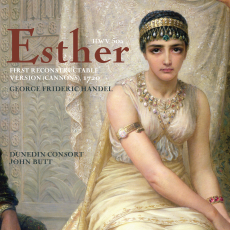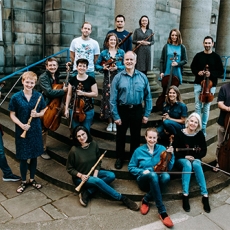Esther - Dunedin Consort - McAlister Matheson Music
Handel's first English oratorio, Esther, was composed during the short period when Handel worked for the Duke of Chandos at Cannons. Its origins are obscure, and while it has become clear that the work went through two versions between 1718 and 1720, much evidence (including Handel's performance score) is missing. New research published in 2010 inspired John Butt to reassess the relationship between the first two versions, examining all the relevant sources in detail. His resulting ‘Esther: first reconstructable version (Cannons), 1720' is a highly appropriate sequel to Acis & Galatea, which the Dunedin Consort presented in 2008 in its 1718 Cannons version. The main characters are Assuerus the Persian king, his evil henchman Haman, Mordecai (the leader of the Jews in Persia) and his orphaned cousin Esther, who has recently been chosen as queen. The plot is straightforward. Haman has ordered that all the Jews be massacred; Mordecai tells Esther, who then pleads with Assuerus to save the Jews; she succeeds, and Haman is condemned to death while the Jews celebrate their freedom. It has been obvious from previous Dunedin Consort recordings that John Butt thrives on translating scholarly research into vibrant performances of the highest quality, and this recording is no different. The opening Overture is a joy in itself, the ensemble beautifully balanced, the music cleanly articulated, unhurried yet with a sense of forward propulsion, with the oboe-playing particularly deserving of mention. The music for the first three tableaux closely resembles that found in Acis, with Matthew Brook in commanding form as Haman, Susan Hamilton a fresh-voiced Esther, and a delightfully boyish-sounding aria from Electra Lochhead, a recent head chorister at St Mary's Episcopal Cathedral in Edinburgh. The drama gathers pace in the second act, with the majority of the movements having their origins in Handel's Brockes Passion. Tenor James Gilchrist is superb as Assuerus, his aria O beauteous Queen especially touching. That aria marks the addition of two bassoons to the ensemble, and in the final act a pair of horns is added in the opening scene and a trumpet in the final chorus. This last is a triumphant, complex movement of unflagging rejoicing incorporating solos and duets, among them a splendid decorated fanfare-like section for two basses. The music is frequently reminiscent of Messiah and the Coronation Anthems; add to that the exceptionally vivid contributions from singers and orchestra, and it looks like the Dunedin Consort have another success to add to their impressive record!


